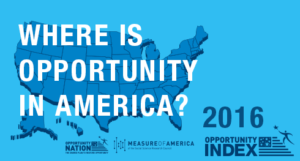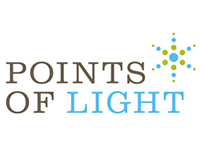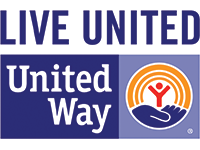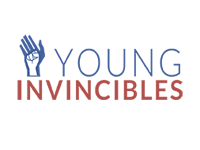After Five Years of Progress, Nation’s Opportunity Score Stalls
 •
•
WASHINGTON, Dec. 13, 2016 /PRNewswire/ — Lower unemployment, increased high school graduation rates and a drop in violent crime, among other factors, drove multiple years of increased opportunity in the U.S., but the nation’s Opportunity Score remained unchanged since last year, according to the 2016 Opportunity Index. Poverty, wages and disconnected youth rates improved since the 2015 Index, but inequality has increased in 45 states and civic engagement weakened.
The annual Index, developed jointly by Measure of America and Opportunity Nation, measures 16 economic, educational and civic indicators that expand or constrict access to economic mobility. The Index ranks each state and grades more than 2,700 counties with an Opportunity Score.
“The country just experienced an election where geography factored into Americans’ experiences on their access to opportunity. The 2016 Opportunity Index tells us that where you live still does play too large a role in access to the American Dream,” said Opportunity Nation Executive Director Monique Rizer. “Where you were born or who your parents are should not determine your future, but today those factors can outweigh hard work and persistence. That should not be. We need to collaborate to create local and national systems that work so every child and young adult can get a fair shot at life.”
The nation’s 2016 Opportunity Score is 54, a 4.4 point increase since the first Index in 2011. Additional 2016 Index findings:
- Prosperity is not shared in all regions:
- New England performed well overall, with four states ranking among the top five states for opportunity
- States in the West and South dominate the bottom five states for opportunity
- Top five states in the 2016 Index: 1) Vermont, 2) Massachusetts, 3) New Hampshire, 4) Connecticut, 5) New Jersey.
- The bottom five states: 51) New Mexico, 50) Nevada, 49) Mississippi, 48) Louisiana, 47) Arizona.
- The top five graded counties in the 2016 Index: Falls Church City County, Virginia; Howard County, Maryland; Hamilton County, Indiana; Williamson County, Tennessee; and Dukes County, Massachusetts.
- The bottom five graded counties are: Star County, Texas; Torrance County, New Mexico; Warren County, Georgia; Yazoo County, Mississippi; and Willacy County, Texas.
- Since the 2011 Index, the rate of violent crime in the U.S. decreased by over 15 percent with 41 states showing improvement in this indicator.
- The strongest correlator with Opportunity Scores is the rate of disconnected youth – young people ages 16 to 24 who are not in school and not working. Youth disconnection has fallen 9.11 percent since 2011 and 4.5 percent since the 2015 Index. Roughly 411,000 fewer young people nationwide are disconnected from both school and work compared to the 2011 Index.
- 5.3 million young people, or 13.2 percent, are considered disconnected youth in the 2016 Index, which is still above pre-recession levels of 12.9 percent.
- Forty-one states reduced their youth disconnection rates.
- Access to grocery stores, group membership, volunteerism and the number of doctors per 100,000 people all declined in 2016.
- The national average of grocery stores and produce vendors per 10,000 people is 2.2. (Down 0.65 percent from 2011, down 1.96 percent from the 2015 Index.)
- The national average of group membership (percentage of adults 18 and older involved in social, civic, sports and religious groups) is 36.2 percent. (Down 3.21 percent from 2011, down 8.98 percent from the 2015 Index.)
- The national average of volunteerism (percentage of adults aged 18 and older who volunteer) is 25.4 percent. (Down 4.10 percent from 2011, down 0.06 percent from the 2015 Index.)
- The national average of medical doctors per 100,000 people is 270.5. (Up four percent from 2011, but down 5.59 percent from the 2015 Index.)
“There is a lot of good news in the Opportunity Index this year. It’s particularly heartening to see the youth disconnection rate continuing to fall, as we know that youth disconnection is an important indicator of community opportunity,” said Kristen Lewis, co-director of Measure of America. “One worrisome exception to the positive findings is income inequality. Income inequality has increased in 45 states since the first iteration of the Index in 2011.”
To illustrate that access to upward mobility varies greatly by geography, and that some states and counties have wider opportunity gaps than others, Opportunity Nation compared two counties. A child growing up in Nassau County, New York has a better chance at going to college, getting a family-sustaining job and living in a safe neighborhood than a child born in Tarrant County, Texas, even though those two counties have similar population sizes (1.3 million and 1.8 million respectively) and the same unemployment rate (3.7 percent). Nassau County, a suburb of New York City, received an A- on the 2016 Opportunity Index, while Tarrant County, a suburb of Fort Worth, received a C. One contributing cause of these grades was the difference in household income: Nassau County has an average income of $90,634 and Tarrant County comes in at $53,170.
Visit www.opportunityindex.org to explore the complete dataset and methodology.









